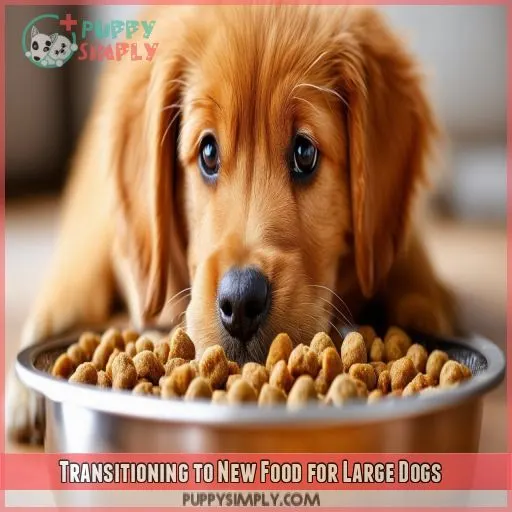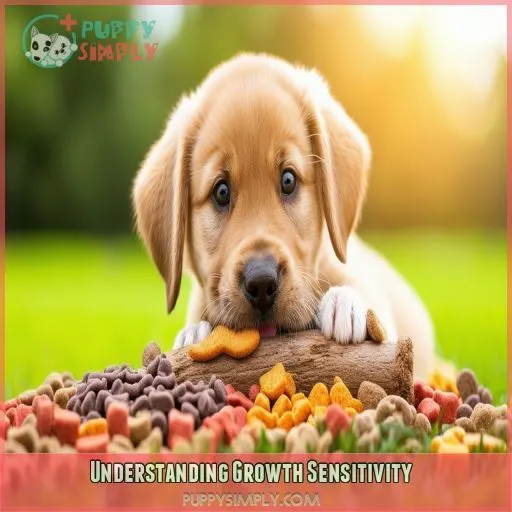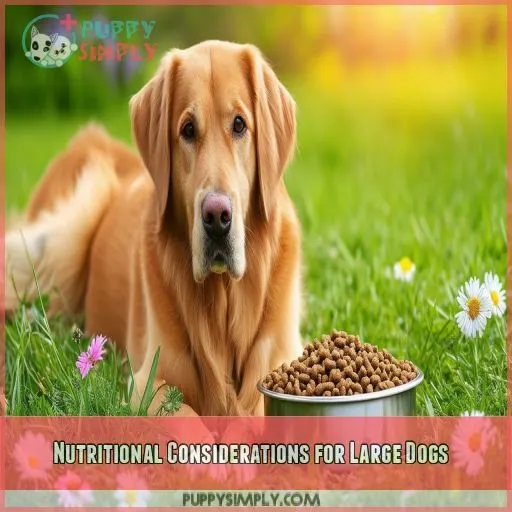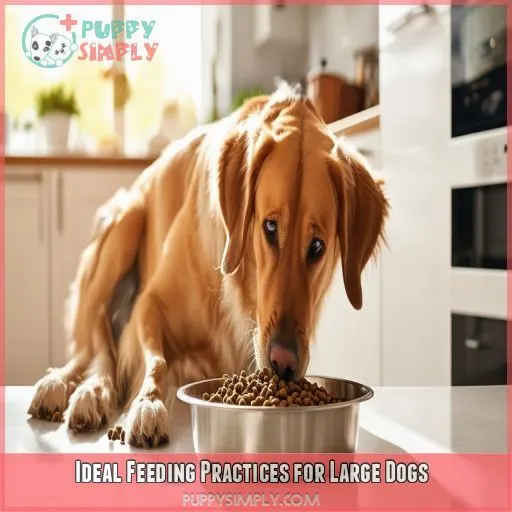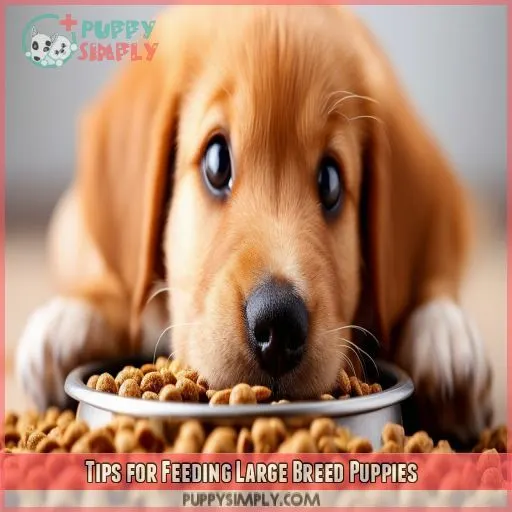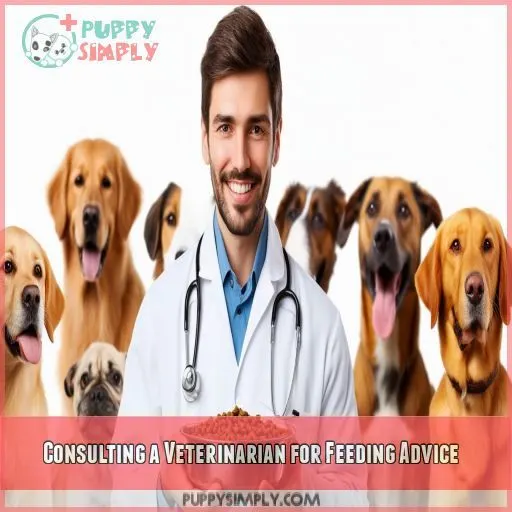This site is supported by our readers. We may earn a commission, at no cost to you, if you purchase through links.
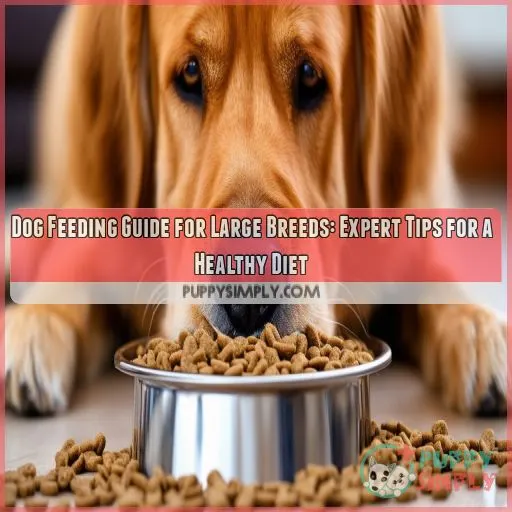 Large breed dogs have unique nutritional needs.
Large breed dogs have unique nutritional needs.
Overfeeding or an imbalanced diet can cause serious health issues.
But don’t worry, this guide will help your furry friend stay healthy.
From switching to new food to calculating daily intake, you’ll learn the best feeding practices for your large dog.
You’ll also discover the ideal nutritional requirements for large breed puppies and adults.
Table Of Contents
- Key Takeaways
- Large Breed Dog Feeding Requirements
- Transitioning to New Food for Large Dogs
- Understanding Growth Sensitivity
- Managing Food Intake Variations
- Nutritional Considerations for Large Dogs
- Nutritional Requirements of Large Breed Puppies
- Ideal Feeding Practices for Large Dogs
- Calculating Daily Food Intake
- Tips for Feeding Large Breed Puppies
- Consulting a Veterinarian for Feeding Advice
- Frequently Asked Questions (FAQs)
- How much food should a large breed dog eat per day?
- What is the recommended feeding chart for dogs?
- What size dog needs large breed food?
- How do I calculate what to feed my dog?
- What if my large breed dog isnt eating much?
- Can I give my large breed puppy treats?
- How often should I feed my large breed dog?
- How much food should I give my large breed puppy?
- Is it okay to feed my large breed dog vegetables?
- Conclusion
Key Takeaways
- Large breed dogs have unique nutritional needs. Overfeeding or an imbalance can cause health issues, so it’s important to be mindful of their daily intake and ideal nutritional requirements.
- Sensitive growth curves and rapid growth spurts mean higher calorie requirements, especially during the first four months. But it’s a delicate balance, as excess calories can lead to obesity and orthopedic issues.
- Managing food intake variations is key. Monitor their body condition score and adjust portions to maintain a healthy weight. Be mindful of hormonal changes, inactivity, and weather conditions that can affect appetite.
- Consult with your veterinarian to determine the best nutritional plan for your large breed dog, including protein, calcium, and phosphorus levels. They’re the experts and can help spot potential health issues early on.
Large Breed Dog Feeding Requirements
Large breed dogs have unique dietary needs that require careful consideration. These gentle giants are prone to developmental orthopedic diseases (DOD) and joint issues, so it’s important to feed them a diet that supports their growing bodies.
When it comes to puppy growth, large breeds have a more sensitive growth curve than their smaller counterparts. Their rapid growth means they require a higher calorie intake, especially during the first four months of life. However, it’s a delicate balance because excess calories can lead to obesity and contribute to orthopedic problems. That’s why it’s important to monitor their food intake and adjust their feeding schedule as they grow.
Switching to new food should be done gradually, especially for large breed puppies. Start by mixing old and new food in equal parts and add probiotics to make sure a smooth switch. Within a few meals, you can have them fully switched to their new diet.
Large breed dogs also have specific nutritional requirements. Their diets should be lower in fat to prevent overfeeding and provide essential nutrients like glucosamine and omega-3 fatty acids for joint health. The right amount of fiber is key, too, as excessive fermentable fiber can cause digestive issues.
When choosing a puppy food, look for an AAFCO statement specific to large breed puppies, making sure complete and balanced nutrition for their unique growth needs. It’s also important to consult with your veterinarian to determine the best protein, calcium, and phosphorus levels for your pup’s healthy development.
Transitioning to New Food for Large Dogs
Changing your large dog’s food needs a careful approach to avoid upsetting their stomach. The best way to switch their diet is to introduce the new food gradually, mixing it with their current food.
For puppies, a 50/50 mix of old and new food is a good starting point, and you can complete the change within 3-4 meals. For adult dogs, start with a 25/75 mix and take 2-3 days to fully change. Adding probiotics during this process can also help ease the change.
It’s also important to follow a feeding schedule and use a feeding chart as a guideline. This helps your dog receive consistent meals and helps you track their food intake.
Understanding Growth Sensitivity
Giant breed puppies have unique nutritional needs during their growth stages. The most sensitive time for growth problems is between 2 and 6 months, with the highest risk occurring between 11 and 16 weeks. This is when they’re most susceptible to developmental orthopedic diseases (DOD) and chronic joint issues.
To prevent these problems, it’s important to feed your giant breed puppy a diet specifically formulated for their needs. These diets have a stricter range for calcium and phosphorus, which are essential for skeletal development but can cause issues if not properly balanced. A moderate amount of protein is also ideal during this stage.
Monitor your puppy’s growth using a growth chart, but always consult your veterinarian for guidance, especially for giant breeds. They can help make sure your puppy receives the proper nutrition to support their unique growth requirements and reduce the risk of health issues later in life.
Managing Food Intake Variations
Managing food intake variations is an important aspect of ensuring your dog maintains a healthy weight. Hormones can impact your dog’s appetite, so be mindful of hormonal changes, such as those associated with coming into season or false pregnancy, which may cause fluctuations in their eating habits. Inactivity can also lead to a reduced appetite, so make sure your dog gets regular exercise.
Interestingly, some dogs are self-regulators when it comes to food, walking away when they’re full. However, individual dogs have individual needs, and some may eat more or less than others. Weather can play a role, too, with extreme conditions reducing energy expenditure and affecting appetite.
To manage these variations, it’s important to monitor your dog’s body condition score, making sure they maintain a lean physique with their last rib slightly visible. Refer to a dog food chart and adjust portions accordingly. For dogs that self-regulate, reduce food intake gradually, perhaps by 1/2 cup per meal or 1 cup per day weekly. Always consult a veterinarian for personalized advice and to address any concerns.
Nutritional Considerations for Large Dogs
As a dog owner, it’s important to understand the unique nutritional needs of large and giant breed dogs. They require fewer calories per body weight and have specific requirements for protein, calcium, phosphorus, and other essential nutrients to support their growth and overall health.
Calorie Requirements
Calorie requirements for large and giant breed puppies are higher than for smaller breeds due to their rapid growth rate. This is especially true during the first four months of life, so monitor their calorie intake and adjust as needed to prevent obesity and potential orthopedic problems.
Protein
Protein is essential for muscle development and energy metabolism. Growing giant breed puppies need more protein than adult dogs, but too much protein can be stored as fat. Talk to your vet to figure out the right amount for your pup.
Calcium
Calcium is really important for your large breed puppy’s skeletal development and overall health. Here are three key things to keep in mind:
- Calcium needs: Large and giant breed puppies have specific calcium requirements to support their growing bones.
- Calcium sources: Make sure your puppy’s diet includes calcium-rich foods.
- Calcium intake: Talk to your veterinarian to figure out the right amount of calcium for your puppy.
Phosphorus
Phosphorus is essential for your dog’s bone health. Deficiencies can cause weak bones and an increased risk of fractures. Excess phosphorus, on the other hand, can lead to skeletal issues and mineral deposits in other tissues.
Feeding Guidelines
When feeding your large breed dog, consider the following:
- Feed multiple small meals throughout the day.
- Use a scale to measure portions accurately.
- Provide enrichment and mental stimulation during mealtimes.
Nutritional Requirements of Large Breed Puppies
As a puppy parent, you want to make sure your large breed puppy gets the best nutrition to support their unique growth needs. These pups need more calories than smaller breeds due to their rapid growth rate, especially during the first four months of life. However, be cautious, as excess calories can lead to obesity and contribute to orthopedic problems.
Protein is essential for muscle development and provides the amino acids needed for tissue growth and energy metabolism. Puppies need more protein than adult dogs, but excess protein can be stored as fat. Consult your veterinarian to find the right protein level for your pup’s age and growth stage.
Calcium and phosphorus are critical for skeletal development and overall health. Large breed puppies have stricter requirements for these minerals than other dogs. A calcium-to-phosphorus ratio of 1.1:1 to 1.4:1 is safe, provided your puppy isn’t overeating.
Don’t forget other important nutrients like vitamin D, vitamin A, copper, zinc, and manganese, which are key for healthy bone development. Choose a puppy food with a balanced profile of these nutrients, and avoid treats that contribute more than 10% of your puppy’s daily calorie intake.
Ideal Feeding Practices for Large Dogs
Feeding large dogs right is a big deal. First off, you need a food made just for big breeds. These foods are usually lower in fat to stop them from getting too chubby and eating too many calories. They also often have stuff that’s good for their joints, like glucosamine and omega-3s, which help keep their bones and joints healthy.
Another thing to think about is how much you feed your big dog. Use a growth chart to keep track of how they’re doing, but don’t be afraid to ask your vet, especially if you’ve got a giant breed. You want them to be lean, with their last rib showing a little bit. This helps prevent weight problems and makes sure they’re getting the right nutrients for their size and how much energy they use.
It’s a good idea to measure their food carefully using a kitchen scale. This makes sure you’re not giving them too much or too little, which can both be bad for them. Remember, every dog is different, so adjust their food as needed, especially if they’re super active or super lazy.
Calculating Daily Food Intake
To figure out how much food your dog needs each day, you need to think about their weight and how active they are. Use a growth chart as a guideline, with males usually needing more food than females. For large breeds, aim for a lean physique, where the last rib is slightly visible. This ideal weight range is key to keeping them healthy.
Feeding charts can give you a starting point, but you might need to adjust the amount of food based on your dog’s individual needs. You may need to give them more or less food to help them stay at their ideal weight. Talk to your veterinarian for personalized advice and to discuss any specific concerns.
Tips for Feeding Large Breed Puppies
Feeding your large breed puppy a proper diet is important for their growth and development. Here are some tips to help your puppy get the nutrition they need:
- Start with a balanced puppy diet: Choose a puppy food specifically formulated for large breeds, as it will have the right balance of nutrients to support their growth.
- Monitor their growth and adjust portions: Keep an eye on your puppy’s weight and adjust their food intake as needed. It’s important to prevent overfeeding, especially when they’re young, to avoid potential health issues.
- Offer treats wisely: Treats can be a great way to reward your puppy, but choose healthy options and don’t overdo it. Opt for low-calorie, nutritious treats like small pieces of boiled chicken or carrots.
Consulting a Veterinarian for Feeding Advice
Your dog’s health is super important, so it’s always a good idea to see a vet. They’re like doctors for dogs, and just as you’d go to a doctor for yourself, your dog’s health is worth a vet visit.
While you might be a pro at taking care of your pooch, vets are the real experts when it comes to feeding advice. They can give you specific tips based on your dog’s unique needs, like a personal trainer for their diet. Plus, they can spot potential health issues before they become a problem.
Frequently Asked Questions (FAQs)
How much food should a large breed dog eat per day?
It depends on your dog’s weight. Large breeds weighing 60-100 pounds should eat 3 to 4 1/2 cups of food per day. Plus, add 1/3 cup for every 10 pounds over 100 pounds.
What is the recommended feeding chart for dogs?
Feeding charts vary depending on the brand of dog food. Consult the feeding chart on your dog food packaging for the recommended amount, which is usually based on a daily intake.
What size dog needs large breed food?
Is your dog tipping the scales? Dogs weighing more than 55-75 lbs are considered large breeds and may benefit from a diet designed for their specific nutritional needs.
How do I calculate what to feed my dog?
First, determine your dog’s ideal weight range. Consult a vet to assess your dog’s body condition score (BCS). Then, calculate their daily food portions by multiplying their weight by 2-3%. Adjust portions based on energy levels, age, and any medical conditions.
What if my large breed dog isnt eating much?
If your large breed dog isn’t eating much, it could be due to environmental factors like hot weather or stress/anxiety. If the issue persists, consult a vet to rule out underlying medical issues.
Can I give my large breed puppy treats?
Yes, but treats should be no more than 10% of your puppy’s daily calorie intake. Look for treats with lower calories, or use a portion of their food as treats. Fruits and vegetables are healthy alternatives.
How often should I feed my large breed dog?
A watched pot never boils. When feeding your large breed dog, it’s best to feed them multiple small meals throughout the day, especially during their rapid growth stage.
How much food should I give my large breed puppy?
Feed large breed puppies 3-4 meals a day. Consult a vet to adjust the amount of food according to their weight, age, and growth curve.
Is it okay to feed my large breed dog vegetables?
Yes, vegetables are a great addition to your dog’s diet, but they shouldn’t be the main source of nutrition. Avoid toxic veggies like grapes, raisins, and onions. Go for raw veggies, crushed or blended, or lightly steamed.
Conclusion
Finally, feeding your large breed dog a proper diet is essential for their health and longevity.
You now have a detailed dog feeding guide for large breeds that covers everything from nutritional requirements to managing food intake variations.


